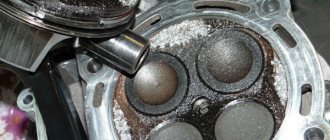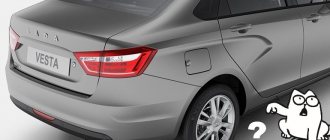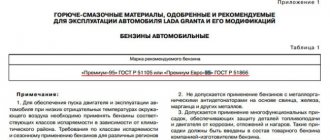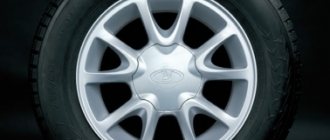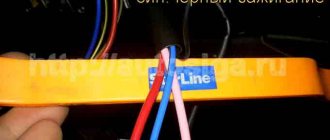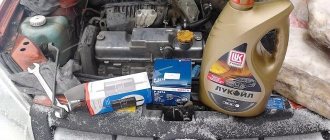A comprehensive answer about the octane number of the gasoline used should be contained in the vehicle operating instructions. But within the AVTOVAZ and Renault-Nissan group there is no single approach - different types of fuel are prescribed for the same engine installed on different models.
LADA > Kalina
Nissan > Almera
Renault > Logan
Renault > Sandero
Look at the table - all presented cars are equipped with engines produced by the Volzhsky Automobile Plant. The source of the fuel data given is the latest operating manuals.
| VAZ-21129, 106 hp | VAZ-21179, 122 hp | H4M, 110 hp | K4M, 102 hp | VAZ-11189, 87 hp | VAZ-21126, 93 hp | VAZ-21116, 87 hp | VAZ-11186, 87 hp | VAZ-21127, 106 hp | VAZ-21214/2123, 83 hp. |
| Lada Vesta | Lada XRAY | Lada Priora | AI-95 is allowed | ||||||
| Lada Granta | AI-95 is allowed | Lada Kalina | AI-95 is allowed | Lada Largus | AI-95 and higher is allowed | AI-92 and higher is allowed | |||
| Lada 4x4 | AI-95 is allowed | ||||||||
| Chevrolet Niva | AI-95 is allowed | ||||||||
| Nissan Almera | AI-91 and higher is allowed | ||||||||
| Datsun on-DO/ mi-Do | AI-95 recommended | ||||||||
| Renault Logan/ Sandero | AI-91 and higher is allowed, AI-87 is allowed |
There are many questions. For example, why does the 16-valve K4M engine developed by the alliance under the hood of the Lada Largus require an AI-95, but in Almere, Logan and Sandero it can work on an AI-91? Moreover, Renault even allows short-term operation on gasoline with an octane rating of 87 according to the research method. There is no such grade in Russia, but low-quality 92nd may end up in the tank, which the engine can cope with at the very least.
The situation is no better with domestically developed engines. Not so long ago, VAZ had a unified technical policy - it was allowed to use “only unleaded gasoline with an octane number of at least 95.” This position of engine developers is justified. It's hard to accept, but understandable. Indeed, the best indicators of efficiency, environmental friendliness and acceleration are achieved with high-octane fuel. Plus the manufacturer’s insurance against low-quality fuel in the regions. The electronic control system will cope with the reduced octane number within reason. Read - it's a re-grade, if instead of 95 the swindlers fill in 92 - nothing will happen to the engine. If 92 is officially allowed, a mixture of 92 and 76 may end up in the tank instead, and this is already fraught.
But a new generation of cars has appeared, and what do we see? For Vesta and XRAY with a VAZ-21129 engine, AI-92 is allowed, and similar engines on Priora, Kalina and Grant under the VAZ-21127 symbol are allowed only AI-95. Or, let’s say, the eight-valve VAZ-11189 for Largus officially swallows the 92nd, but give the same Kalina VAZ-11186 engine only the 95th. The wording is also a mess: for technically identical Lada and Datsun, in one case it is allowed, in the other it is recommended.
Engines Lada Granta
There are five engine models on the VAZ Lada Granta:
Each of these motors has many features. The table clearly reflects their parameters.
The determining indicator for choosing gasoline is the compression ratio. The upper limit for AI-92 is considered to be 10.5.
In all operating manuals, the manufacturer prescribes only unleaded gasoline with an octane rating of at least 95. As for forced sixteen-valve cars, they require AI-95. But what kind of gasoline is better to fill in an 8-valve Granta - 92 or 95, doubt may arise here.
Real fuel consumption figures
Some cars are produced with 8 valves in engines. There are versions with 84 hp. and 87 hp The manufacturer promises that these cars will “eat” 10.5-10.6 liters on city streets and 6.5-6.9 liters on the highway. In reality, the values differ greatly.
For 84 hp engines. and 87 hp have approximately the same consumption in real conditions. The values are as follows:
- When driving in the city, in traffic jams and difficult traffic conditions - 12.4-13.8 l;
- If you often have to drive on the highway, between cities – 8.2-8.9 liters;
- When driving in the combined cycle - 10.1-10.9 liters.
Power plants 102 hp, 105 hp and 106 hp consume more gasoline than less powerful versions. However, the numbers are quite adequate, which contribute to fuel savings. In real conditions, the indicators are:
- Driving on city roads – 12.6-13.9 l;
- Driving on highways – 8.6-9.4 l;
- Driving both on the road and on the highway – 10.5-11.6 liters.
It must be borne in mind that consumption figures fluctuate greatly, depending on environmental conditions. In winter and at low temperatures, the specified gasoline consumption standards increase.
Those cars that are equipped with engines of 102 hp, 105 hp. and 106 hp have a basic design with 16 valves. This had a good effect on the power and dynamics of the car. Unfortunately, a negative trend towards increased gasoline consumption has emerged. For all these three engine variations, the numbers are approximately the same - we list them:
- Operating the car in the city, on a busy road – 12.5-13.6 l;
- Driving between populated areas on the highway – 8.9-9.7 l;
- Mixed operating cycle – 10.3-10.9 l.
What can happen to the engine if you fill it with the wrong fuel?
In fact, the manufacturer requires the use of only 95 gasoline for the most modest power plants - for 11186, but even for 11183-50 the use of 92 gasoline is not allowed, even as the maximum permissible . However, after pouring this fuel into the tank of their cars, many owners did not notice any differences in the operation of the engines.
One of the owners wrote that no changes occurred, except that detonation appeared. Another said that he examined the inside of the cylinder using an endoscope. This is a device that allows you to look into hard-to-reach places using a flexible or rigid rod. He said he didn't notice any wear on the cylinder walls.
Why is detonation dangerous?
Differences
But first, let's talk in a nutshell about the differences between these two most popular brands offered at gas stations. After all, many drivers, especially beginners, think that the 95 is of higher quality compared to the 92 and cannot harm the engine. But the opposite is true.
Higher gasolines are produced on the basis of 92nd
, by adding to it all sorts of additives that can increase the octane number. Therefore, 92 is cleaner than its counterparts, it turns out (although, according to experts, in the Russian expanses, especially in the outback, it is difficult to find fuel that is not created with the help of additives, even 92). But the same experts claim that due to the low octane, 92 and there are few additives, and it itself is cleaner.
By the way, adding these chemicals and bringing raw materials to rank 95 costs gas stations less than purchasing the same material from oil refineries. That's why so many people are doing body blows. Such a homemade 95 can be extremely dangerous for the engine, since the buyer does not know for certain what has been added to it!
https://youtube.com/watch?v=qbE2p5FAz9A
Which gasoline drives the Lada Granta better - 92 or 95
Most motorists agree that speed and dynamic performance, as well as uniformity of operation, are better with fuel recommended by the manufacturer. Nobody said that the AI-95 is worse to drive. Some argue that there is no difference. Most likely, they prefer a calm driving style, so the dynamics are not very noticeable.
Is it worth filling in 92nd gasoline?
Proponents of cheap fuel often refer to a knock sensor, which will save you from a destructive blast wave. Having perceived its signal, the machine will adjust the ignition timing and the composition of the working mixture.
That's exactly what will happen. The sensor will work, but after the first shocks appear, and the settings will change not for the sake of dynamics and efficiency, but to save the engine. The ignition timing will decrease. Most likely the car will reduce traction. The fuel will burn out at the end of the exhaust, overheating the exhaust valves over and over again. Of course, they won't burn out right away. The service life of the motor will decrease gradually.
Why the manufacturer insists on using 95 even at a low compression ratio is difficult to understand. There is a version that manufacturers consider this fuel to be more refined. Someone mentions a note in the documentation about ensuring good vaporization of the product. See what gasoline is recommended for Lada Vesta.
Many owners note that the AI-92 is prone to increased carbon formation, spark plugs burn out faster, and the fuel system becomes clogged.
Is it possible to save money on cheap fuel?
A legitimate question arises: why is the Lada Vesta allowed to use AI-92 on all types of engines, and even on Renault-Nissan with a compression ratio of 10.7 and other sixteen-valve engines. It is possible that on the VAZ-11183 engine, as on the first injection unit, the manufacturers played it safe by introducing a high-tech fuel system . And then it stayed that way.
Quote from one review, which is perhaps the most accurate: “You pay no more. You pay less. The consumption of the 92nd increases by 7 percent, and the 95th is more expensive by 6 percent. The car runs well at 95, but at 92 it’s so-so.”
The issue of quality also speaks in favor of 95 gasoline. Not every gas station has a fuel octane rating that matches its name. So 95 may turn out to be 92, but 92 is something unknown. The risk of sometimes getting completely unusable fuel when using AI-92 is greater. See also recommendations on which gasoline is best for Lada Vesta.
The colors of gasoline vary: AI-76 is pink, AI-92, 95 is red or orange, AI-98 is blue.
Source
FakeHeader
Comments 27
There's not much going on at 21127. It becomes more lively, but it’s not worth the overpayment, IMHO.
They bring me 100 from LUKoil, no problems so far, engine 21116
98 is possible, just a waste of money, it says 95th, lei 95th
The 8 valve runs well on it. Nothing will happen. I drove about 10,000 kilometers on it. But the 16-valve engine does not perform well on pure 98. A mixture of 98 and 95 in the region of 96-96.5 works well for it: it spins well, the engine runs quieter and softer. It’s unpleasant to drive a clean 95m Lukoilovsky after this mixture: like a tractor in comparison. Overpayment of 50 rubles when refueling
30 liters. At one gas station I pour 98 and then top up with 95)
in our realities - with gasoline becoming more expensive, you need to buy Lukoil 100 gasoline))) but it’s better to switch to LPG
Fill it in, 98 is better than 92. Maybe 98 will turn out to be 95 in real life. And about the warmed up valves from 98 - these are stories.
On the contrary, the valves burn due to low octane number. Because the mixture burns out at the inlet. That's right, stories. Both 98 and 100 can be poured, nothing will happen, the ECU will correct the UOS
Moreover, if the Grant is equipped with a 11186 engine, high-octane gasoline is better than detonation.
On the contrary, the valves burn due to low octane number. Because the mixture burns out at the inlet. That's right, stories. Both 98 and 100 can be poured, nothing will happen, the ECU will correct the UOS
your theory is not correct, high-octane gasoline burns more slowly and therefore there is less detonation
High-actane gasoline is more resistant to detonation (self-ignition); the burning rate has nothing to do with it!
and are these values independent of each other? During normal engine operation, the working mixture enters the cylinder, is ignited by a spark, and the flame front propagates at a speed of 10-20 m/sec. At the beginning of the power stroke, temperature and pressure, due to the ignition of part of the fuel, begin to increase; if the fuel has low anti-knock resistance (low octane number), then the rest of the mixture begins to burn explosively - at a speed of 1500-2500 m/sec. (100 times more than during normal combustion)
That’s the point: under normal conditions, ignition occurs with a spark, but with low-actane gasoline, self-ignition of the combustible mixture occurs not in the center of the combustion chamber, but in random places, which leads to overheating of parts and possible destruction! But the burning rate of 92 and 98 will be the same, the only difference is that 92 will detonate before 98!
if the burning rate is the same, why then is there an ignition advance, which the ECU constantly adjusts, and since when did engines running 76 gasoline begin to run without spark plugs, let’s say an engine running on 92 is filled with 98, both without ignition do not detonate, but for 98 the ECU will increase the OZ , why, if in your opinion the burning rate is the same?
What kind of gasoline should I fill in the Lada Granta?
The question “Which gasoline to choose 92 or 95” worries almost every car enthusiast. AVTOVAZ recommends using AI 95 gasoline on all Lada Granta engines.
However, many owners actively use cheaper AI 92 fuel. A minority spare no expense and fill the tank with AI 98 or AI 98 G-drive. So what kind of gasoline is better to fill in?
Quite a lot of research has been done on the topic “Which gasoline is better.” For example, the Autoreview website testing Renault Sandero and Hyundai Solaris cars on AI 92 and AI 95 gasoline came to the conclusion that the Renault Sandero on AI 95 accelerates better and is more economical than its competitor in the Hyundai Solaris test. It turns out that the efficiency and dynamics of a car running on different fuels directly depends on the type of engine.
Conducting a survey among owners of the tenth family of VAZs, it turned out that the majority of drivers noticed a slight increase in dynamics in comparison with the AI 92 on the AI 95. In addition, a car with AI-95 is slightly more economical than with AI 92.
Other sources, studying gasoline with different octane numbers, claim that compared to AI 92, AI 95 will not increase power by much, only by 0.1 hp. They say that a reduced octane number of gasoline will negatively affect engine performance, which in the future may result in a major engine overhaul.
Let us remind you that the fuel consumption of the Lada Granta depends not only on the quality of gasoline. What kind of gasoline do you recommend to fill in the Lada Granta?
Source
What do drivers think about this?
If you read the reviews of the Lada Granta owners themselves, you may encounter some contradictions. Some argue that AI-92 gasoline is perfect for Lada, except that detonation appears in the combustion chamber.
Other drivers argue that only AI-95 is suitable for the Lada Granta, and even note that it is this gasoline that helps save on fuel consumption.
This octane number of gasoline has a positive effect on the fuel consumption of a car. If the average speed of a car is from 90 to 100 km/h, using 95 gasoline, about 5.5 liters of gasoline are consumed.
There is a third group of car owners who fill the tank with gasoline of both brands, which is why the results are not very good. Drivers mix two types of gasoline in order to reduce detonation and average gasoline consumption, but experts still do not recommend mixing different types of gasoline.
Car owners who buy AI-92 do not see a significant difference in the car's dynamics, engine performance and gasoline consumption. If you replace the fuel recommended in the instructions for use with AI-92, then the only difference will be the effect on the fuel system.
Only 95 gasoline?
AvtoVAZ recommends 95 type gasoline
Modern VAZ cars are equipped with a large number of electronic systems that require good treatment and quality care. This also applies to the brand of fuel that is filled into the tank.
According to the official documentation of the Lada Grant, this car must consume exclusively A-95 gasoline.
But is it worth adhering to the recommendation, or can you deviate from it a little? Now we will find out about this.
Is it possible to refuel with A-92 gasoline?
There is such a thing as octane number, which is determined in digital terms by the name of the fuel. If the vehicle in question is recommended to use 95 gasoline, there are reasons for this.
The fact is that the engine, which is designed for A-95 gasoline, can start working with any type of fuel. He won't do octane tests. Instead, to put it simply, it will treat any gasoline as if it were A-95, compressing it accordingly.
And, given that A-92 fuel has an octane rating of three units less, its possible compression ratio may be lower than in the case of the recommended fuel. This may not be noticeable if the engine has already traveled more than one or two hundred thousand kilometers, since the compression performance of the combustion chamber decreases somewhat.
Try to refuel at large chain gas stations.
If you fill in with high-quality 92-grade gasoline, then no errors will appear on the instrument panel after starting the engine; this is precisely the main argument of those who like to refuel with gasoline with a lower octane number.
But, in the case of proper technical condition, as well as a new car, it will compress the working mixture to the maximum. And gasoline with a lower grade is not designed for this. So, if you do not want to hear the sounds of detonation, and also eliminate premature wear of car parts in the near future, then you should listen to the recommendations of the car exactly what is written in the operating instructions.
Video of a test measurement of the real octane number of 92 gasoline
The video below shows the process of measuring the octane number of gasoline that was purchased at regular gas stations in Novosibirsk. Only one sampler showed the presence of truly 92-grade gasoline.
And the operating instructions for the Lada Grant indicate gasoline of at least 95.
Simply put, the result of using any fuel with a lower grade will be the appearance of unintended detonations and difficulty starting a cold engine. They are very small local explosions that damage the condition of the cylinder and, to some extent, the piston. Moreover, all this can lead to increased wear and, most importantly, increased fuel consumption. So any attempts to save on cheaper gasoline will be doomed to failure.
What then to do with “older” gasoline?
Let's fill up with 98?
If you consider the above information, you might think that it would then be advisable to fill your car with gasoline with a higher octane number. For example, this could be the A-98, which is the standard for many modern foreign-made cars.
But here again we will have to disappoint you, since the mechanism requires a clear and correct attitude towards itself. Therefore, if the compression ratio is designed for A-95, then A-98 gasoline will be compressed to exactly the same level. And the potential of this fuel can only be revealed when its compression force is higher, which the Lada Grant engine is not designed for.
The result of refueling with 98-grade gasoline will be the inability to use its properties to the maximum, and you will simply lose your money due to the difference in the cost of gasoline of different brands.
A few words about American and turbocharged engines
I was also bombarded with the following questions: “I bought a car imported from the USA, it says that you need to use AKI 91 gasoline. What is this, and what kind of fuel should I choose?”
The US market has slightly different standards; their classification is not like ours (that is, “research”). The abbreviation AKI means a conditional, average designation of two indices ((“research” + “motor”)/2).
If we bring it closer to our standards, we get something like this:
AKI87 = AI92
AKI89-91 = AI95
AKI93 = AI98
I would also like to note the turbocharged options; in the last article I said that it is recommended to use at least “95” in them.
Let's think logically, why 95 and 98? Turbocharged engines use much larger volumes of air and fuel, the mixture in them must be richer, and from the points above we understood what ENRICHED fuel is, it gives us more octane. Think for yourself - WHY BUY A TURBO, AND FURTHER FEED IT WITH LEAN MICHES, it’s just not designed for that! The amount of air must strictly correspond to the caloric content of the fuel.
It is also worth noting that when using the “92”, as many manufacturers indicate, the “required temperature regime” may be violated, which may lead to the failure of some components, in particular the “turbine” itself.
Therefore, in TURBO, only what the doctor ordered, otherwise it is fraught with repairs.
Now there is a video version of the article, VERY USEFUL.
I’ll end here, I think it was useful, sincerely YOUR AUTOBLOGGER.
(24 votes, average: 4.58 out of 5)
Similar news
What gasoline is better in winter in cold weather? Let's consider brands 92 and 95, again.
How gasoline is made from oil. How much can you get from a liter + by.
Propane or methane. What is better for the car? And what's the difference between them?
Features of the national gas station
But, this is all theory. The fact is that in our country the fuel situation is not as rosy as one might expect. Often, the required octane number in the fuel sold is achieved by using special chemicals called “additives” (as in the video above). Thus, a chemical analysis will show that this number corresponds to the brand, while the car may not want to work fully with this gasoline. In this case, you will have to drain all the gasoline from the tank and clean it.
And most domestic oil refineries do not have equipment that could process oil into gasoline grades higher than A-92. It is for this reason that “there is a popular opinion” that there is basically no difference between brands with an octane number greater than 92.
But the cost of gasoline will vary significantly. In addition, the savings on the “correct” fuel are not so high in terms of its consumption, which does not cover additional material costs. The exception is the exclusively urban driving cycle, where trips are made mainly in low gears and, often, at high speeds of the power unit.
However, this is the opinion of people, but not of automobile experts. And improper operation is rarely associated with one’s own carelessness. Instead, complaints begin to arise about the build quality of the machine itself.
How does the car manual answer this question?
Let's figure it out. The first note states that the required flammability at low temperatures must be ensured.
It follows from this that fuel must be selected of a certain volatility class. In different regions of the Russian Federation, this requirement is adhered to differently, and fuel volatility classes differ from each other based on location.
The second obstacle to the use of low-octane gasoline is various metal and organic particles, which are anti-knock agents and are contained in gasoline. The presence of lead, cadmium, manganese, iron and other metals can be observed in the particles.
Various additive materials are introduced into high-octane gasoline to prevent the formation of soot, various deposits and corrosion. But these substances can only be included in gasoline by its manufacturer. Every motorist can do this, but experts do not recommend doing this, since substances can be introduced in the wrong proportion.
This is interesting: What is the volume of oil in the Lada Vesta engine
Thanks Don't like romych79 21 Oct 2013
Each region probably has its own signs of good gasoline
I have one sign (in an unfamiliar place): if the gas station is full of people, and there is a gas station “resting” nearby, it’s better to stop by among the people. but unfortunately, it’s mostly done at random or by advice, and even then they’ll flood such crap.
I remembered an incident: I was once driving along an unfamiliar road, there was little gasoline left, and the next one was dry. when it will be. We came across a gas station that looked like it was from pre-Soviet times, somewhere in a field far from the roads. I had to pour a little to get to the highway. I don’t know what kind of gasoline this is, but I would pour it into all containers where possible. I couldn’t hear the engine, it worked like a Swiss watch and consumption dropped by a liter and a half. I have never seen such gasoline at “beautiful new gas stations with cafes and shops.”
Are there savings?
When drivers argue about whether it is possible to fill in 92 gasoline instead of 95, they often use saving money as an argument. In fact, the savings are so tiny (1-2 rubles per liter) that they practically do not exist. On average, a driver can save 3-4 thousand rubles per year (with a mileage of about 15,000 km). However, systematic use of the “wrong” gasoline may lead to loss of the right to warranty repairs. Many car owners were denied warranty service after analyzing the fuel used. Therefore, savings of 3-4 thousand rubles can ultimately result in a large amount spent on major repairs of the cylinder-piston group of the power plant.
The process of changing the oil in a manual transmission yourself
- We install the car on the inspection channel. Alternatively, use a hydraulic lifting mechanism, a road overpass.
- We fix the wheels with wheel chocks and apply the handbrake.
- Open the hood and unscrew the filler cap.
- Under the bottom, near the right drive, unscrew the drain plug (hexagon) and drain the waste into an empty container.
- We wait 10 - 15 minutes until the maximum complete drainage. The less waste remains inside, the more useful components will be retained in the lubricant.
- Screw in the drain plug.
- We unscrew the filler plug at the top of the manual transmission and pour 3.2 liters of new fluid into the gearbox.
- We wait 3 - 4 minutes for the liquid to sink to the bottom of the crankcase. We start the engine and test the car.
Typical beginner mistakes
- purchasing engine/transmission fluid out of season;
- insufficient level/exceeding the maximum lubricant level;
- reusing an old filter;
- aggressive driving style;
- failure to meet deadlines for replacing consumables.
